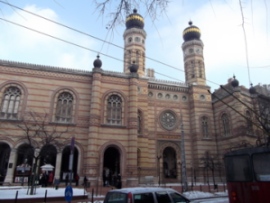By Merav Levkowitz
 On the last evening of 2010, a Friday, about 35-40 (mostly) young adults, gathered in a non-descript apartment in the center of Budapest’s—actually on the Pest side of the Danube river—Jewish quarter. This is Budapest’s branch of Moishe House, an organization that maintains 33 houses around the world in which young Jews can gather for Shabbat, holidays, and activities. I spent the last Shabbat of the year at Budapest’s Moishe House, which had become my brother’s Jewish community during his semester abroad.
On the last evening of 2010, a Friday, about 35-40 (mostly) young adults, gathered in a non-descript apartment in the center of Budapest’s—actually on the Pest side of the Danube river—Jewish quarter. This is Budapest’s branch of Moishe House, an organization that maintains 33 houses around the world in which young Jews can gather for Shabbat, holidays, and activities. I spent the last Shabbat of the year at Budapest’s Moishe House, which had become my brother’s Jewish community during his semester abroad.
Hungary’s Jewish community has a unique, but tumultuous history. Jews have resided in the Austro-Hungarian empire and in Buda, Obuda, and Pest—the three towns that came together as Hungary’s capital, Budapest, in 1873—since medieval times. As in other European countries, Jews in the region experienced waves of safety and success interspersed with those of discrimination and expulsion. Following the Ottoman conquest of Buda, Jews were dispersed throughout central Hungary and the Balkans, where they lived in relative calm until the Habsburgs, the ruling royal family, imposed new restrictions during their late 17th century reign. In December 1867 Jews were granted full emancipation, and the period that followed was one of prosperity and assimilation of the Jewish community into Hungary. During this time, Hungary’s unique Neolog Jewish movement, which seeks middle-ground religiosity and is most like the American Conservative movement, gained popularity. The movement’s majestic and regal synagogue, the Dohany Street Great Synagogue—the largest in Europe and the second largest in the world—hosted major community events and still serves as the emblem and gatekeeper to the city’s famous Jewish quarter behind it.
Today Hungary is home to an estimated 100,000 Jews, one of the largest Jewish communities in Europe, and Budapest houses over twenty synagogues and a hip, vibrant Jewish quarter that is familiar to all who live in the city and is actively advertised as a “Must See” in all travel guides. Yet, it also seems hidden and cloaked in mystery. Many of the Jews we met did not even know they were Jewish for most of their lives.
Both World War II and the subsequent communism eroded the Hungarian Jewish community and identity. While the discourse has long held that Hungarian Jews perished at the hands of the occupying Nazi German forces, the relatively new Holocaust Memorial Center in Budapest ascribes distinct responsibility to the Hungarian state, arguing that beginning in 1938 the state undertook a process by which it deprived Jews and Roma, in particular, of their “rights, property, freedom, human dignity, and in the end, their very existence.” Budapest’s Jews were confined to the tragic conditions of the Jewish ghetto until their deportation was carried out. Indeed, the deportation of Hungarian Jews was the fastest and most extensive—437,402 Jews from Hungary deported within 56 days—and one-tenth of the Holocaust’s Jewish victims were Hungarian.
After the Holocaust’s devastation, the subsequent communist regime turned the remaining Hungarian Jews away from the religion. Many Jewish families were active communists, but even those that were not kept Judaism under wraps. One family friend, now in her late 50s, told us that as a child, most of the families she knew, including her own, were atheists. Once she learned, as an adult, that her family was Jewish, she discovered that all her atheist childhood friends were also, in fact, originally Jewish. Another adult friend shared that as a child he had been told that his grandmother lived in England. He was surprised, when she came to visit, that she did not speak any English and was told that she lived in an area of England that was predominantly Hungarian. As an adult, he, too, learned that he was Jewish and that his grandmother had, in fact, been living in Tel Aviv. Hungarian Jews of all ages shared similar stories.
Today, Budapest’s Jews seem caught in a tug-of-war. On one hand, Jewish life and culture seems active, alive, and on the rise, especially among young adults. On the other hand, however, many Hungarians expressed fear about the current government, which has censored the press and includes a faction of members of the nationalist, anti-Semitic, far-right party Jobbik. Many Hungarian Jews I met espoused concern for a future and a desire to make aliyah, especially if the political climate continues as is. Indeed, even as I, a tourist, roamed the colorful and vibrant Jewish neighborhood and visited the impressive—but empty—Holocaust Memorial Center, I could not help but feel that the residual fears of the Holocaust and communism had settled over the city and that the Jewish community was, in fact, one of ghosts.

3 thoughts on “Jewish Ghosts of Budapest”
Great article.
As a former resident of Budapest, I would just like to clarify that the presence of Jews in Hungary actually far predates medieval times, and goes back to the period of the late Roman Empire. A Roman garrison site, called Aquincum, whose ruins still exist near the current city of Budapest was inhabited by Jews who followed the expanding Roman Empire to set-up shops and services to serve the needs of the Roman troops. Tombstones inscribed in Hebrew have been discovered from this period and can now be seen in the Jewish Museum in Budapest. Therefore, interestingly, Jews have resided in Hungary before even the Hungarian tribes settled in the region.